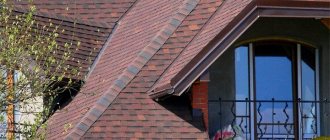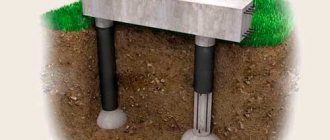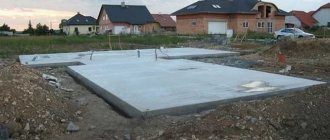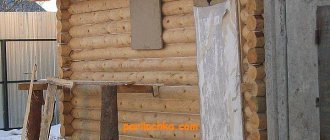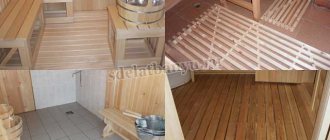Despite the high temperatures in the steam room, below it rarely exceeds 30 degrees, but there is constantly high humidity on the floor. Therefore, when arranging a floor in such conditions, there are some peculiarities.
In this article we will tell you about how to make a floor in a bathhouse on the ground, the preparation process and laying schemes for a wooden floor.
Finishing the floor and walls of the bathhouse with wood
What is the difficulty of insulating the floor in a bathhouse?
Very often, a bathhouse is a separate house in the country. It’s rare for anyone to maintain above-zero temperatures in winter. More often it is “heated” only for use and this is the difficulty. For insulation, you need a material that can withstand frost/defrost and is not afraid of moisture. After all, if we are talking about a Russian bath, and not a sauna, then the humidity in the steam room will be close to 90%. In other rooms, perhaps lower, but also far from normal. So, there are two criteria for choosing insulation: it should not be afraid of periodic heating, and it should also tolerate humidity normally or not absorb moisture at all.
Typically, a bathhouse and a change house often appear on the site first. And only then does the construction of the house begin
Another option to choose from is security. Baths are usually heated by wood stoves, and in most cases the buildings themselves are made of wood. The combination of open fire and wood is always dangerous. Therefore, it is advisable to insulate with non-flammable material. But there are no such things, and therefore they try to choose one that has a high ignition temperature, does not smoke when burning, and does not spread combustion.
How and with what to insulate the floor in a bathhouse. Choosing the best options
There are also requirements for floor construction. We don’t heat a bathhouse every day, even if it is in the yard, and therefore the design must be thought out so that during “downtime” the materials are dried. To do this, you need a working and well-thought-out ventilation system, a blown/ventilated subfloor. Otherwise, literally in a couple of years everything will have to be redone.
Pros and cons of concrete pavement
Filled floors are characterized by strength, reliability, durability and heat resistance. They don't rot. Concrete does not require special care. A large selection of cladding will allow you to realize any design idea.
Pouring a floor in a bathhouse is a labor-intensive and costly process. It will cost more than wood. Arranging the base takes a long time, as the material must harden. Without an additional heating system, the surface will be cold and requires the installation of running grates. The unattractive appearance requires decorative finishing.
Despite all the shortcomings, concrete will serve properly for 30-40 years, provided that high-quality materials and building codes are used.
Insulation materials
In general, the floor in a bathhouse can be insulated with any insulation material. There are rooms with different operating modes and the floor structure may be different. Let's look at the most common materials that can be used to insulate a bath.
- Foam glass (foam glass). Not to say that it is widespread, but it is an ideal option in all respects for any room. Foam glass does not get wet, is not afraid of moisture, frost, can withstand temperatures up to 100°C without problems, does not emit anything, does not burn, does not support combustion. It, like ordinary glass, melts at a very high temperature and does not emit anything. It has very good thermal insulation characteristics; a small layer is needed to achieve the required degree of protection. The material has low vapor permeability and this must be kept in mind when choosing a floor design. There is only one drawback - the price. Foam glass comes in the form of blocks, granules, and you can also find scraps. The most expensive blocks are (about $350 per cube), the cheapest are scraps (about $40 per cube). Blocks can be placed between the logs, granules and trimmings can be used as backfill. This is a much more effective (but also more expensive) replacement for expanded clay.
New technologies bring new materials. For example, foam glass is almost ideal as insulation - Expanded polystyrene (not foam). The best option is extruded polystyrene foam. It can be placed in the screed or between the joists. It has excellent thermal insulation properties and does not absorb water (or rather, it does, but in a very small amount). Up to a temperature of 95°C it is environmentally safe, but above that it begins to release not the most beneficial substances. In relation to floor insulation in a bathhouse, it can be installed in any room. The floor is not walls and it simply has no chance of heating above 40°C. But polystyrene foam is flammable and vapor-proof. That is, good ventilation is needed.
How to insulate floors in a bathhouse and with what depends on how you are going to make them - Mineral wool.
- Stone wool can only be used in dry rooms. She will work great here. It is better to insulate the floor in a bathhouse using a different material. If you want mineral wool, look at glass wool. The humidity in the bathhouse is still high. If wet stone wool freezes, it does not restore its properties after freezing, but immediately loses them by 40%. So after two frosts there will be nothing left. Just rubbish that doesn't affect anything at all.
Glass wool is very itchy, but is not afraid of moisture, which is very important in a bathhouse
Working with glass wool is difficult and difficult. It pricks even through overalls. But she is not afraid of getting wet. It also slightly reduces its properties when wet, but after drying the characteristics remain almost unchanged.
From old memory, many still remember such insulation as expanded clay. Until there was an alternative, it could still be considered insulation. Now, to replace a layer of mineral wool with a thickness of, for example, 8 cm, you need to pour 40 cm of expanded clay. Yes, it is cheap, but it is afraid of water, which makes it completely unattractive.
Are the same drugs suitable for different rooms?
Before choosing an impregnation, you need to decide on the purpose of its use, since each compartment of the bath has a different level of humidity. It is important to remember that the products used for floors should not emit harmful substances or have a strong odor. Due to the fact that there are high temperatures in the sink and steam room, there is a threat of evaporation from the surface of the treated floor, which can be harmful to health.
To prevent the negative effects of impregnation preparations on the body, it is necessary to remember the following.
- In the rest room and locker room, the air temperature usually does not exceed 28 degrees. Therefore, synthetic impregnations can be used in these rooms.
- The washing room is dominated by high temperature and humidity. The wooden floor there must be impregnated with only organic-based products.
Protective impregnations are presented in a fairly wide range. Modern means make it possible to combat the destructive process - first of all, rotting. To make the right choice, pay attention to the properties of impregnations and correlate them with the characteristics of your bathhouse or sauna - this is the only way you can find the ideal protection option specifically for your case.
Bath floor pie
There are two types of rooms in the bathhouse. The first - with high humidity and large quantities of water - is a steam room and shower. The second is with conditions that can be called “normal”. This is usually the locker room and rest room. Sometimes these are two rooms, sometimes one. There may also be a firebox, but more often the stove is heated from the rest room, and its rear part opens into the steam room.
There is no right solution. Everyone chooses their own. About a dozen options
How to make a floor in the “dry rooms” of a bathhouse
The locker room and rest room have a regular insulated floor. But “regular” gender can also be different. In the sense that there are several ways to arrange it. What they usually agree on is that these rooms have wooden floors. Still, it is more comfortable and the room becomes warmer faster. In this case, the floor structure itself may be different:
- The floor is on the ground with concrete preparation and the floor is on joists. This option is good on soils with high humidity, as it allows for high-quality waterproofing of the floor. But you need to think about frost heaving so that the slab doesn’t “bruise.”
Still, wooden floors feel the warmest - Wooden insulated floor with joists. This means that the logs rest on the foundation or its frame. If necessary, fold the posts that support the beam between the support points. A cheaper option, which, however, retains heat well with proper selection of materials.
If you don’t want to make a wooden floor in the bathhouse, then make a standard concrete floor pie on the ground. But this option is more suitable for baths with constant heating. It is impossible to warm up a concrete slab quickly. In this case, you can consider electric floor heating. To prevent your feet from getting cold, you can lay downed ladders on the floor.
Water drainage must be provided in the washing room/shower room and in the steam room. These are so-called “wet” rooms and their floor pattern is different. And the device is also different.
Floor without rough concrete screed
A floor of this design is laid directly on a strip or column foundation.
The free space between the elements of the base of the building is filled with a solution of rough concrete. Instead, you can use a compacted soil pad. It is necessary to build a tray in the center of the steam room, connecting it to the sewer pipe. This will make it easier for waste water to drain away. To make a tray, you can use boards or plastic. The base for it is one of the supporting elements of the foundation. A waterproofing material must be laid under the tray.
The final floor covering is made of tightly laid boards. The slope created during the installation of the floor ensures that waste water flows directly into the tray and then into the sewer pipe.
Shower floors in the steam room
Let's start with the fact that the floor in the steam room is made only of wood. The tile, firstly, has a high heat capacity. By the time it warms up, it will be time to go home. Secondly, it can get so hot that even felt boots won’t save you. So, the floor in the steam room is wooden, but it can be torrential or not. Torrential is when the finished flooring of boards is deliberately made to be cracked. The board is laid with a gap of 5 mm or so. And under the flooring there is a rough floor, with a slope towards the drain, and the drain through the ladder leads into a drain hole or sewer.
In the washroom/shower room and in the steam room, you can make a leaky/spillable floor
With such a floor arrangement, you can pour water into the steam room. Even in bathhouses that are not heated in winter, until everything cools down it will dry out. True, if there is ventilation and it works well. To be more confident, you can not nail down the flooring, but make wooden ladders, which after the bath can be taken outside or into a more ventilated room to dry.
Insulation: how to lay materials
But what about insulating the floor in a bathhouse with such a device? And the floor under the bottom layer needs to be insulated. If as in the picture (the floor is along the joists), then nail the cranial bars. They can be a support for stacked polystyrene foam or foam glass blocks. The distance between the insulation and the timber is filled with foam.
For loose types of insulation, pieces of sheet moisture-resistant material (OSB or moisture-resistant plywood) are laid on the skull blocks. Expanded clay, granulated foam glass or its cuttings are poured into the resulting “troughs”.
The leaking floor in the bathhouse consists of two “layers”. The first one from the bottom is waterproof with a built-in drain/drain for water. The second is wooden slotted flooring
To lay mineral wool slabs between joists you can:
- pull a cord or wire or strong synthetic twine “snake”;
- line it with a net (albeit a plastic one);
- stuff thin slats.
Mineral wool slabs are laid at random. Their width should be slightly larger than the width of the trough - by 2-3 cm. Then the material holds well, and cracks do not form during “shrinkage”.
Protection of insulation from soil moisture
When using mineral wool, expanded clay or foam glass granules, the insulation must be protected from moisture in the soil. It is always there and there is always evaporation. At the same time, no matter how hard you try, some of the moist air will get from the premises into the insulation. And this moisture must be removed. Where? Usually in the underground, in which ventilation holes (vents) are made. That is, if the floor was insulated with mineral wool, expanded clay, broken or granulated foam glass, we nail a membrane from below on the subfloor side.
To maintain the normal condition of the insulation, membranes are needed
The membrane must have one-sided vapor conductivity. It should release steam from the insulation, but not let it in. There are such membranes. They are nailed using clamping strips. The holes that are formed in this case are additionally sealed. Only in combination with protection from moisture, the insulation of the floor in the bathhouse will be durable. Otherwise, you will get problems in a year.
When using slabs made of foam glass or expanded polystyrene, additional protection from moisture is not needed. Both materials do not absorb moisture and practically do not conduct steam.
Which sealant is suitable for a bath
Taking into account the microclimate that is created in the bathhouse, the main requirements for the composition for sealing joints and cracks in floors are:
- moisture resistance;
- heat resistance, resistance to temperature changes.
Also, the sealant must have good adhesion to the materials from which the subfloor and floor covering are made. It needs to be suitable for interior work and not emit toxic substances, especially when heated. Sealing wood structures requires a sealant with high elasticity that can adapt to the thermal expansion of the wood. Acrylic, silicone and polyurethane compounds meet these requirements:
- acrylic sealants are excellent for wooden surfaces, but for rooms with high humidity levels you need to select waterproof (siliconized) compounds. Conventional acrylic sealants are quickly destroyed in such conditions;
- silicone ones have excellent water-repellent characteristics. For a bath, neutral heat-resistant compounds are suitable that can withstand a wide range of temperatures, acidic, and have good adhesion to wood and ceramic tiles. You can use special sanitary sealants that are resistant to the spread of fungus;
- Polyurethane sealants have excellent adhesion to wood; they prevent water leaks and floor blowing, cracking of wood, and its damage by rot and mold.
Non-spillable floor in the steam room
The non-spillable floor in the steam room is made of tongue-and-groove boards and has an organized drain. The boards are laid with a slope towards the drain. The floor drain is a concrete or metal (less commonly) gutter. The slope of the board is small - 1 cm per meter. Do not need anymore.
How are non-leakage floors constructed in a bathhouse - in a steam room or shower/wash room
That is, structurally it is an ordinary wooden floor. Except that you have to make a drain. It is done either at the wall opposite the shelf, or as in the picture above, in the middle.
The insulation of the floor in a bathhouse of this design is similar to that described above. Except that:
- Thermal insulation material must be protected from moisture, which still seeps through the wooden flooring. But you also need to remove the moisture that has already got there. So again we need a membrane with one-way conductivity. It is placed so that moisture is not allowed into the insulation, but vapor is released. Below, by the way, under the insulation, if your soil is open and concrete preparation has not been made with waterproofing laid out, a membrane is also needed. It is nailed as described above.
How to make a drain in a steam room with a wooden floor - There must be an air gap between the top edge of the insulating material and the flooring. It is needed so that the moisture that settles on the membrane can evaporate. A ventilation gap is provided with wooden slats (thickness of at least 20 mm), which are placed across the joists.
How to insulate floors in a bathhouse and with what: floor insulation scheme by joists
In general, the cake is standard. That is, we insulate the floor in the bathhouse according to the usual scheme. The whole difference is in the thickness of the insulation and the presence of a gutter for drainage. And the thickness of the insulation in the steam room is taken taking into account the fact that it needs to be heated as quickly as possible. Therefore, they usually take 50% more layers than for ordinary rooms.
Finished floor installation
A finishing coating can be laid on the finished base. The boards are pre-treated with special compounds to protect against microorganisms and mold.
The covering is laid tightly. It is better to use tongue-and-groove boards with a tongue-and-groove joint. As a result, a smooth, even surface is formed without gaps, cracks, etc. Skirting boards are installed along the walls. On top of the drainage hole there is a removable sheathing. Important! All technological gaps around the drain must be filled with sealant and additionally treated with a compound to increase moisture resistance.
Tiled floor in the sink of a wooden bathhouse
The tiles can be laid on a screed. In this case, you need to make a traditional concrete floor with concrete preparation. You just need to remember that you need to organize the flow of water. So immediately decide on the level of the finishing coating, set up a drain (drain), lay the pipes. Then you can start making the floor.
The technology, in fact, differs only at the very end - it is necessary to form a slope towards the ladder. And so, everything is the same. The bottom of the pit is compacted, crushed stone is laid out in layers, and compacted. Next, you can make a slab with a strength of M150 and a thickness of 3.5-4 cm, or pour crushed stone with lean concrete. The second option is more economical. Wait until the concrete reaches 50% strength and you can continue. To prepare, lay waterproofing and insulation on top. How to insulate the floor in a bathhouse in this case? Expanded polystyrene is optimal. It behaves normally in the screed, the layer is not too large, and is not afraid of moisture. In general, there is no better one.
How to make a tiled floor in a washroom
We lay expanded polystyrene in two layers. The slabs of the second layer overlap the seams of the first. This is for better thermal insulation. The first layer slabs can be attached to the base with long nails with plastic heads. The sheets are glued together with tape, you can foam the seams with foam, cut off the excess and lay out the second layer. You can simply lay it down, you can fix it with something. In principle, it will not go anywhere in a small washroom. We glue the seams of the second layer of polystyrene foam with tape. This is necessary so that the solution is not poured into the cracks - it will worsen the thermal insulation.
The floor in the shower also needs to be insulated
Next, spread a layer of PVC film on the polystyrene foam. This, again, is to prevent the solution from flowing. We roll out a damper tape around the perimeter of the room, lay out reinforcement or reinforcing mesh, set up beacons (don’t forget to form a slight slope towards the ladder) and fill in the screed. Once the concrete has hardened sufficiently, the tiles can be laid. But even with insulation, it will feel cold. There are two options - knock down the wooden gratings or use electric heating. Cable mats are ideal under the tiles. In a couple of hours, with normal thermal insulation, they will warm the floor.
Is it possible to lay tiles if the floor is made with joists? Quite. Again, there are options. You can lay plywood on the subfloor (don’t forget about the slope). Or maybe not plywood, but slate sheets. It is even preferable, since their thermal expansion with tiles is closer than with plywood. Then you can lay the tiles using a special tile adhesive. Special - this is for complex unstable foundations. It is expensive, but the cost of preparatory layers is less.
Still, in wet areas there is nothing better than tiles
You can also pour screed onto the plywood and lay tiles on it. But this makes sense if you are using water heating for the floor from heating or from a warm water tank. If it is electric, then it can be laid directly on plywood.
Manufacturing of support pillars
To prevent the logs from deflecting due to the weight of people or steam room equipment, it is necessary to make support pillars (chairs) for them in the weakest places. The weakest point, naturally, will be the center of the joist. In our example, it is enough to install two supports with a cross-section of 250×250 mm along the central longitudinal axis of the steam room. Chairs can be made of wood, brick or concrete. We will consider the last option.
Preparing the base
- Mark places for support tables.
- Dig a hole 400 mm deep. The dimensions of the pit in plan should be such that it would be easy to install formwork from edged boards.
- Place a layer of sand at the bottom of the hole, pour water on it, and compact it with an unnecessary piece of wood. The thickness of the compacted layer should be about 100 mm.
- Pour 150 mm thick crushed stone on top of the sand layer and compact it well too. As a result, we should have a total layer with a height of 250 mm.
- From edged boards, construct a formwork for a square post 250 x 250 mm, the inner surface of which is covered with rolled roofing felt. The height of the formwork should ensure that concrete is poured to the top level of the strip foundation.
- Inside the formwork, lay steel reinforcement from a ø10 mm bar in the form of a flat lattice with four cells 75 x 75 mm. Tie the rods together with steel wire. Place broken bricks under the grating so that the distance from the reinforcement to the crushed stone layer is about 50 mm, and from the walls of the formwork no more than 50 mm.
Return to content
Pouring concrete
- Prepare a concrete solution in the ratio cement: sand: fine gravel – 1: 3: 5. The consistency of the solution should be above average, allowing it to be compacted well.
- Pour a 50 mm thick layer of concrete and compact it. Place steel reinforcement on it from a ø10 mm bar in the form of a flat lattice with four cells 75 x 75 mm. Tie the rods together with steel wire. Make sure that the distance from the reinforcement to the formwork walls is no more than 50 mm.
- Place the rest of the concrete mortar on top of the reinforcement, compact it, level it on top of the formwork and make the screed with an even block or lath.
- Leave for a couple of days for the concrete to set. When the concrete is sufficiently strong, it’s time to begin installing the floor.
- All subsequent work on installing the support beams and, in general, all the logs in general, depends on how the support pillars are made and their level relative to the upper level of the bathhouse foundation. Therefore, in order to make your work easier, the supporting platforms of the pillars should be as close as possible to the conventional plane passing along the upper surfaces of the walls of the bathhouse foundation.
Return to content

